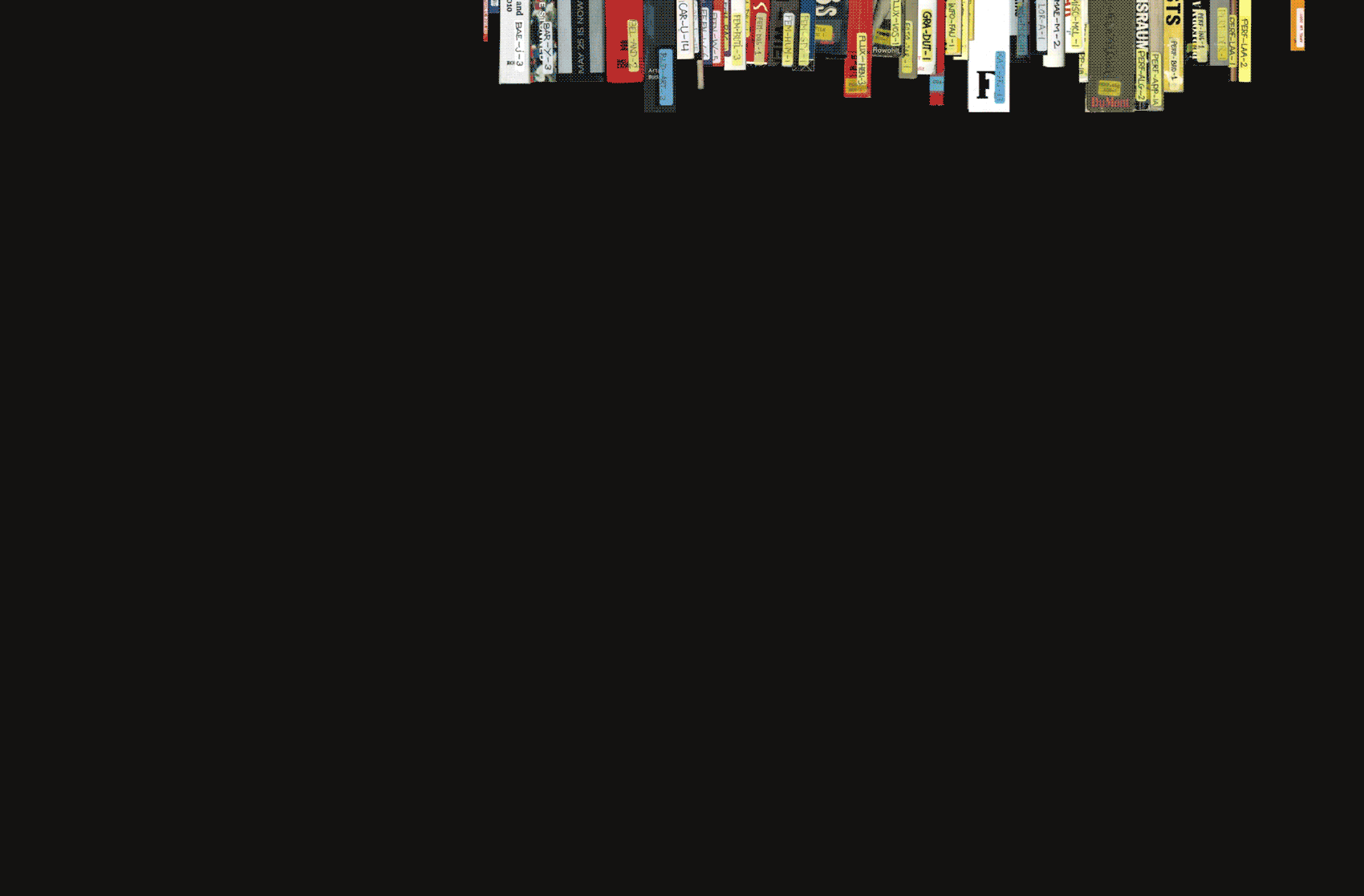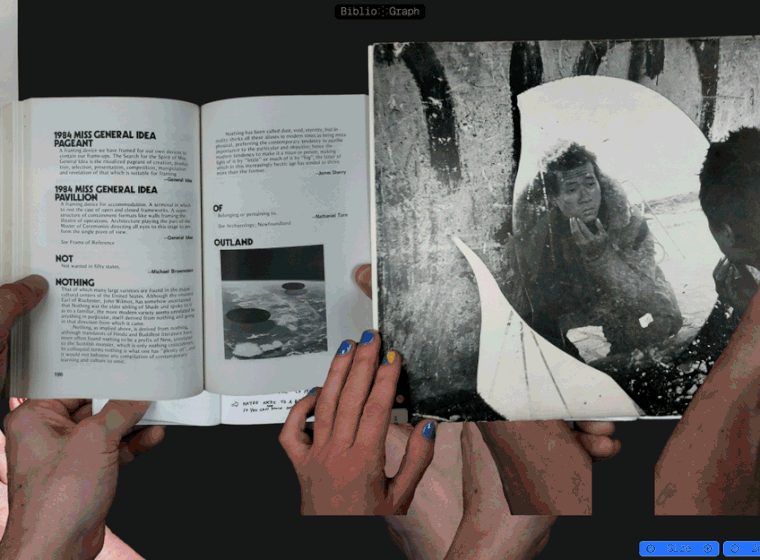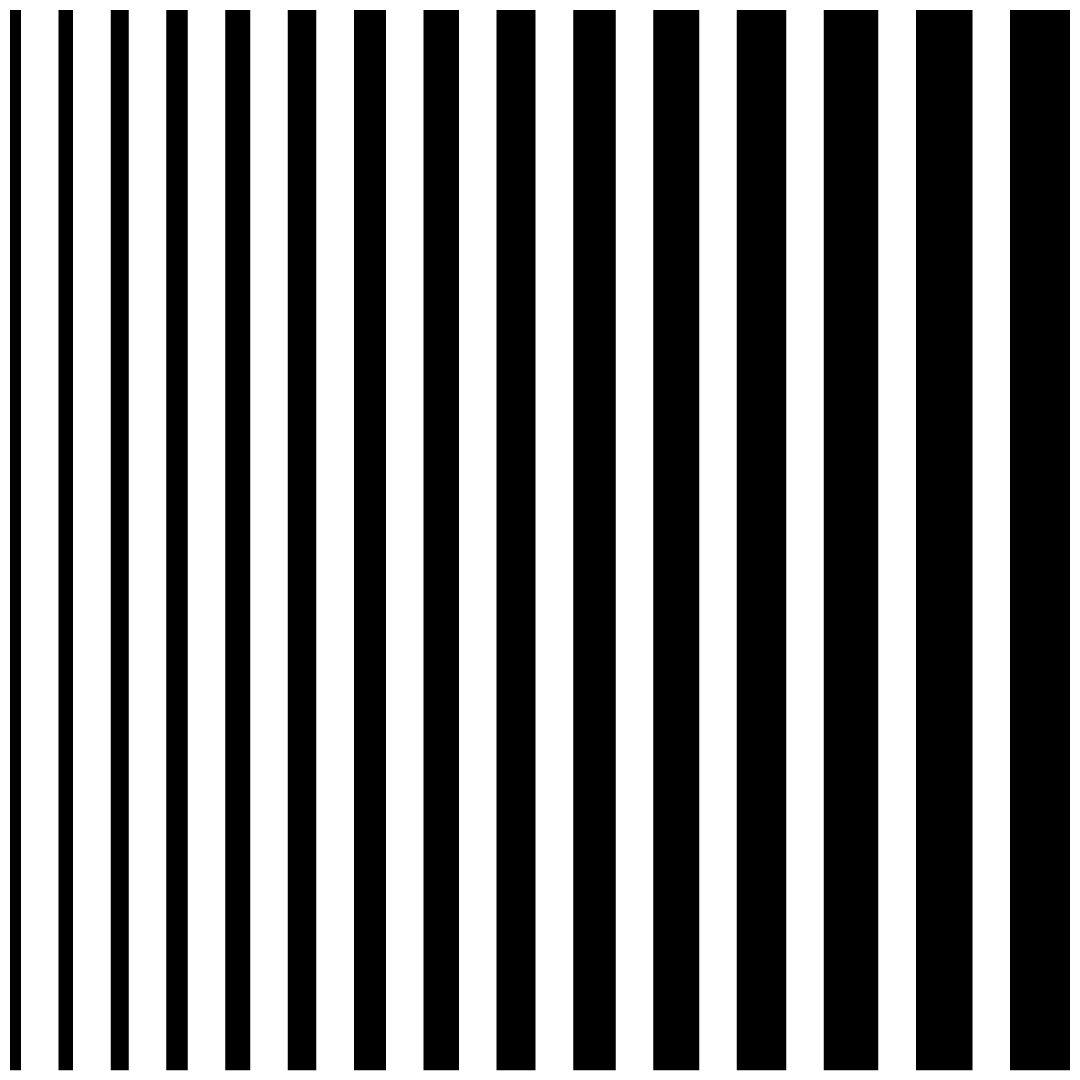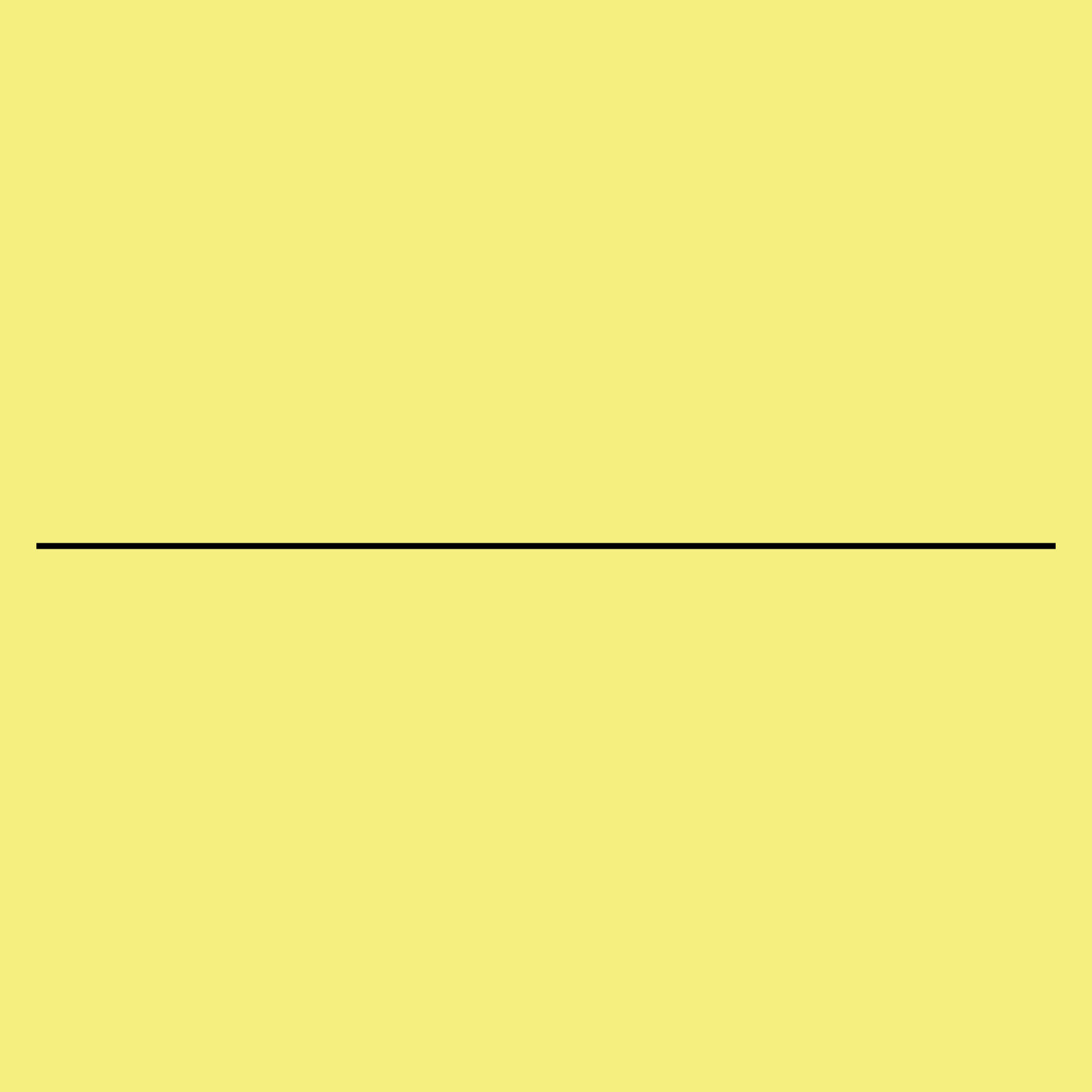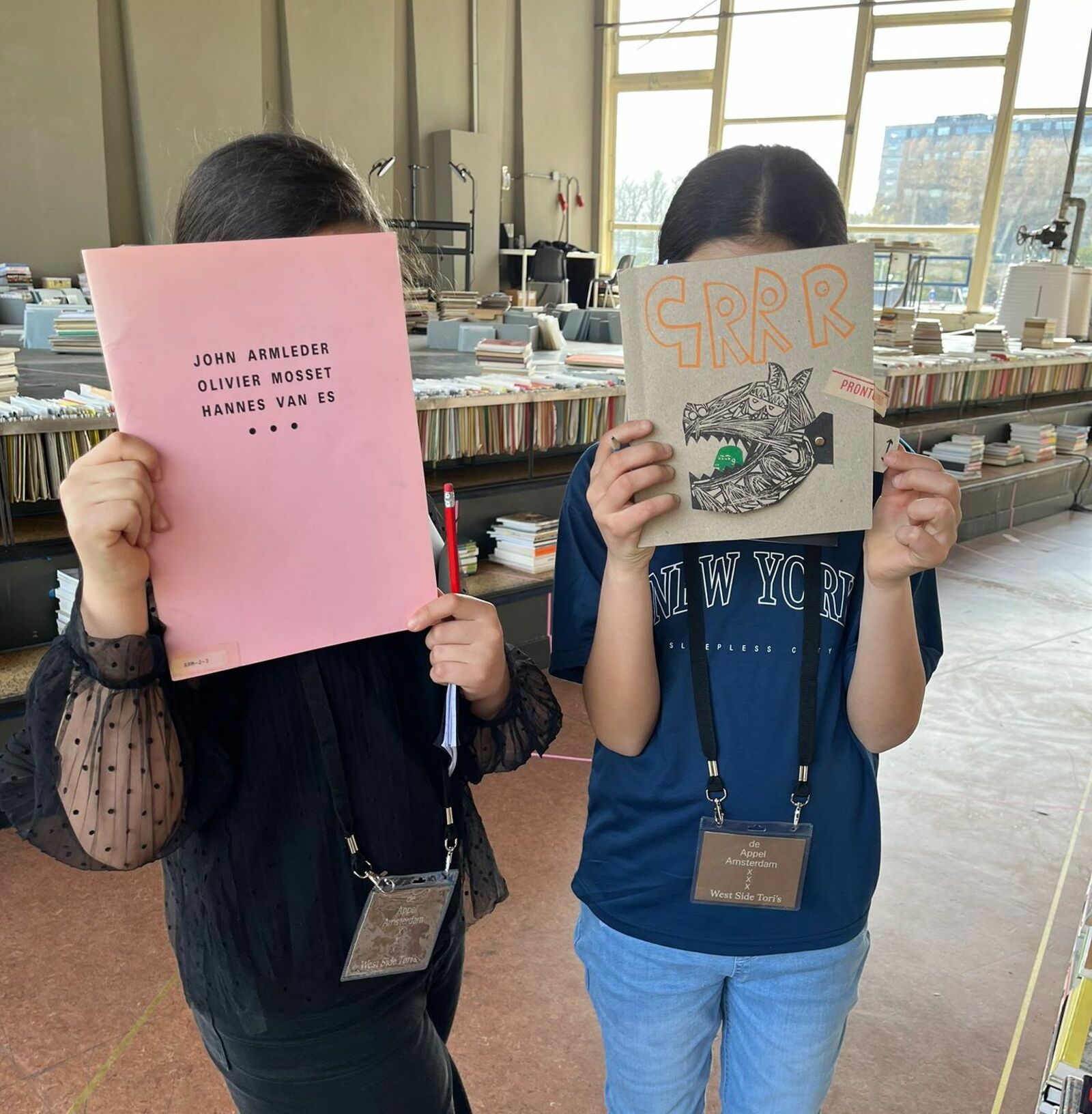Catching Up in the Archive
Table Guest: Simon Browne, Silvio Lorusso and Danny Tirthdas van der Kleij from Varia Rotterdam
varia (Gouwstraat 3, Rotterdam) is a space for developing collective approaches to everyday technology. As varia members, we maintain and facilitate a collective infrastructure from which we generate questions, opinions, modifications, help and action. We work with free software, organise events and collaborate in different constellations. varia figures things out as they go.
See the transcript of their conversation at de Appel below
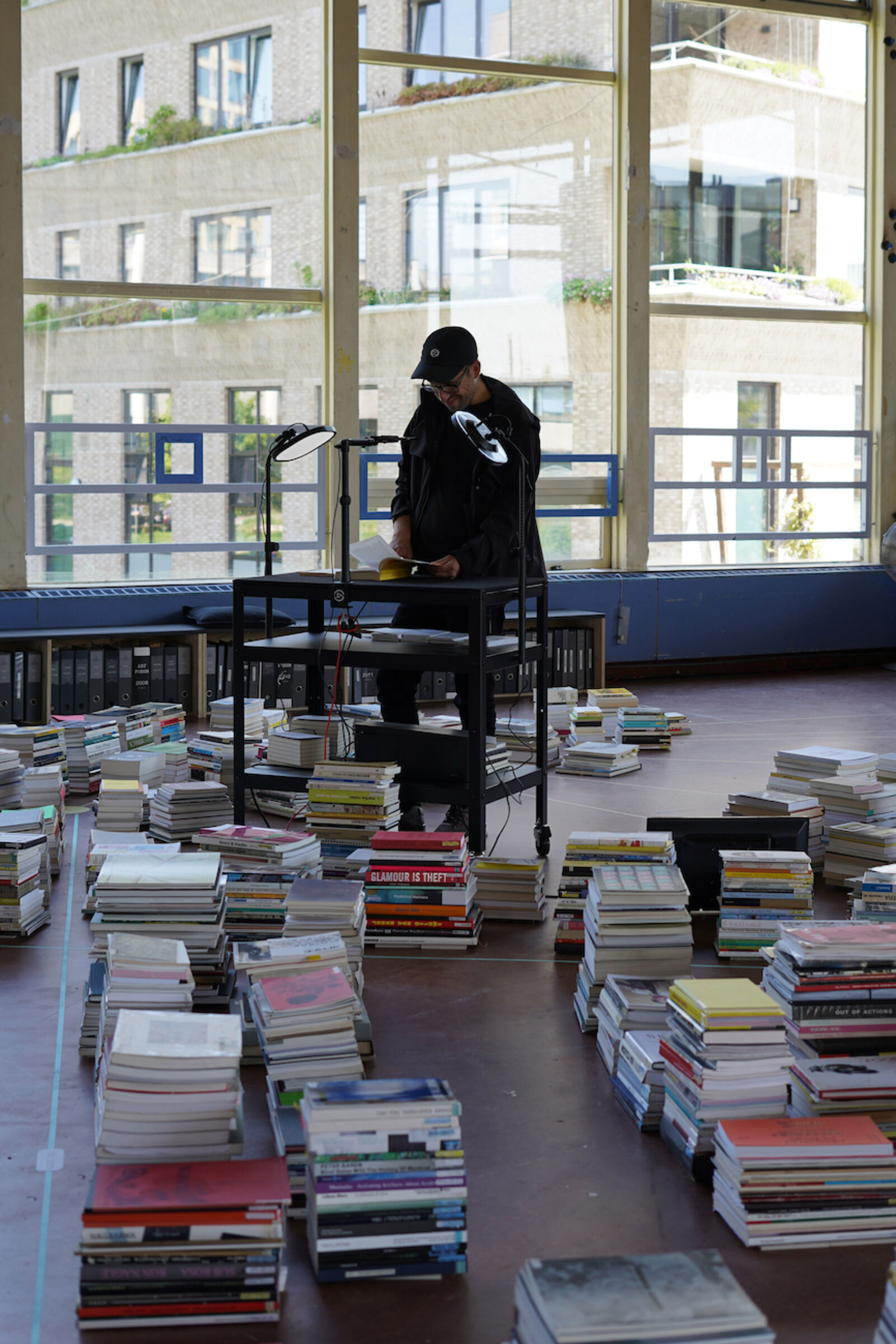
photo: Remco van Bladel
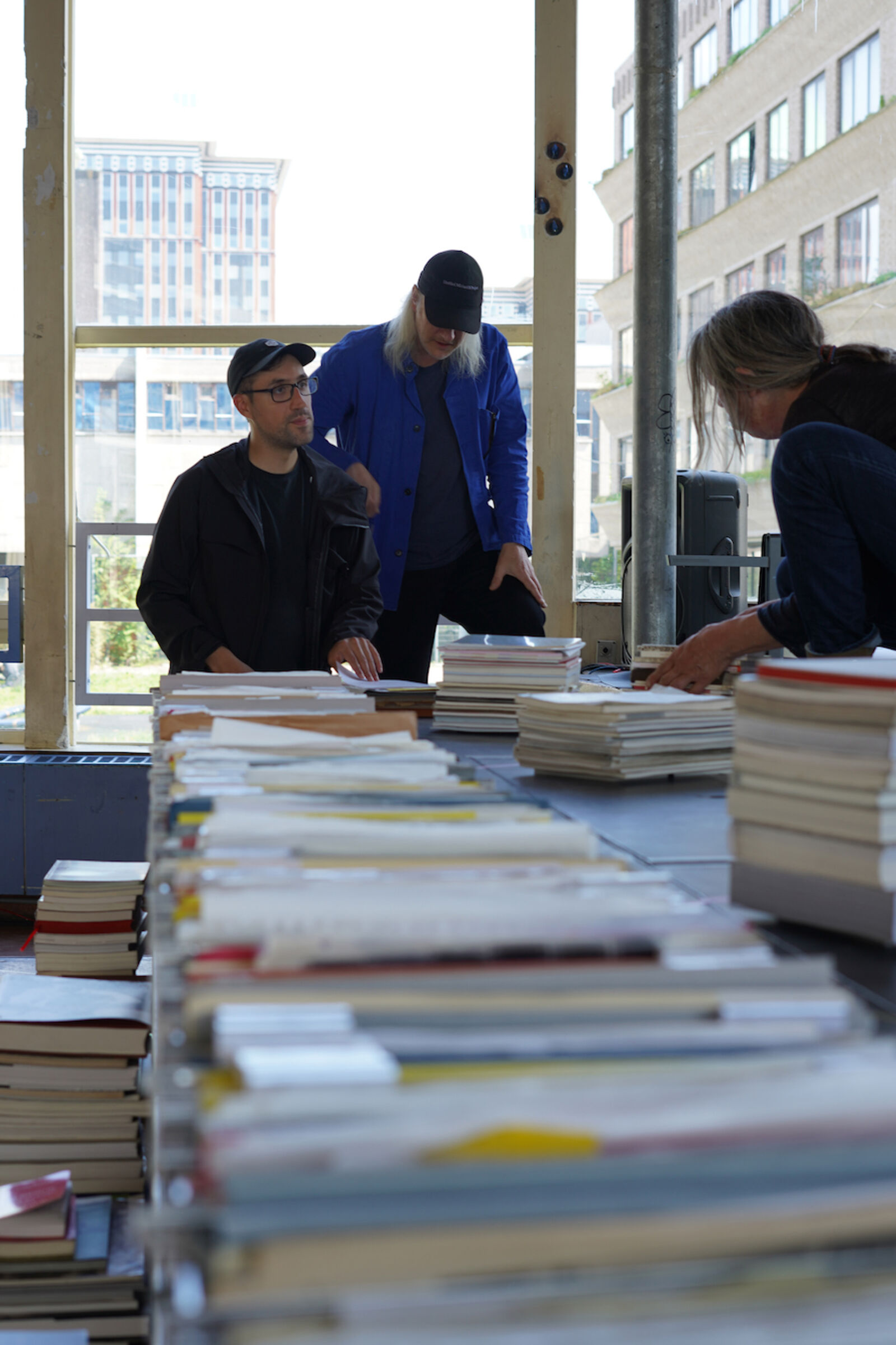
photo: Remco van Bladel
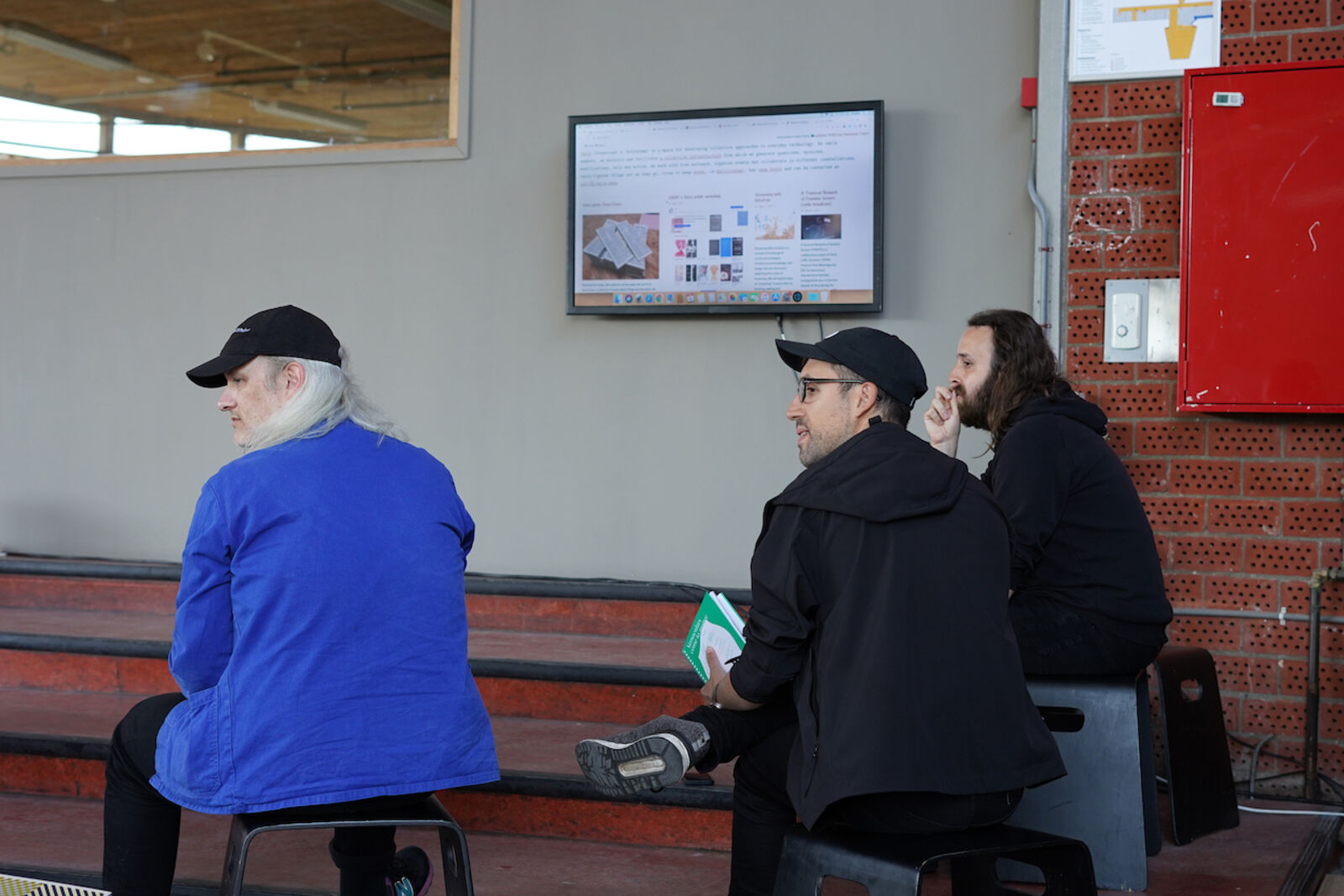
From left to right: Simon Browne, Silvio Lorusso, Danny Tirthdas van der Kleij. Photo: Remco van Bladel

Photo: Remco van Bladel
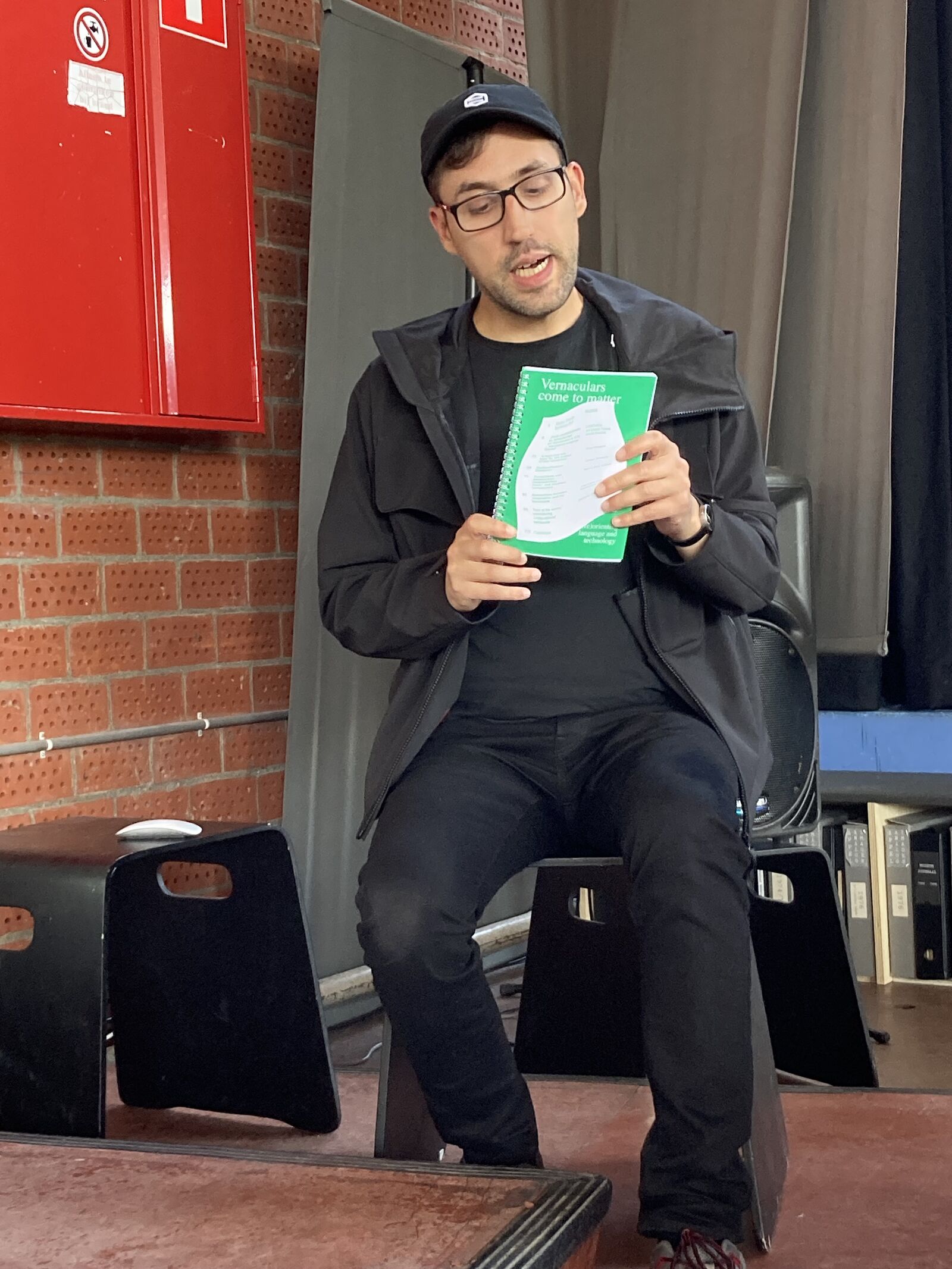
Silvio Lorusso presents “Vernaculars come to matter” Everyday Technology Press, Rotterdam, 2021

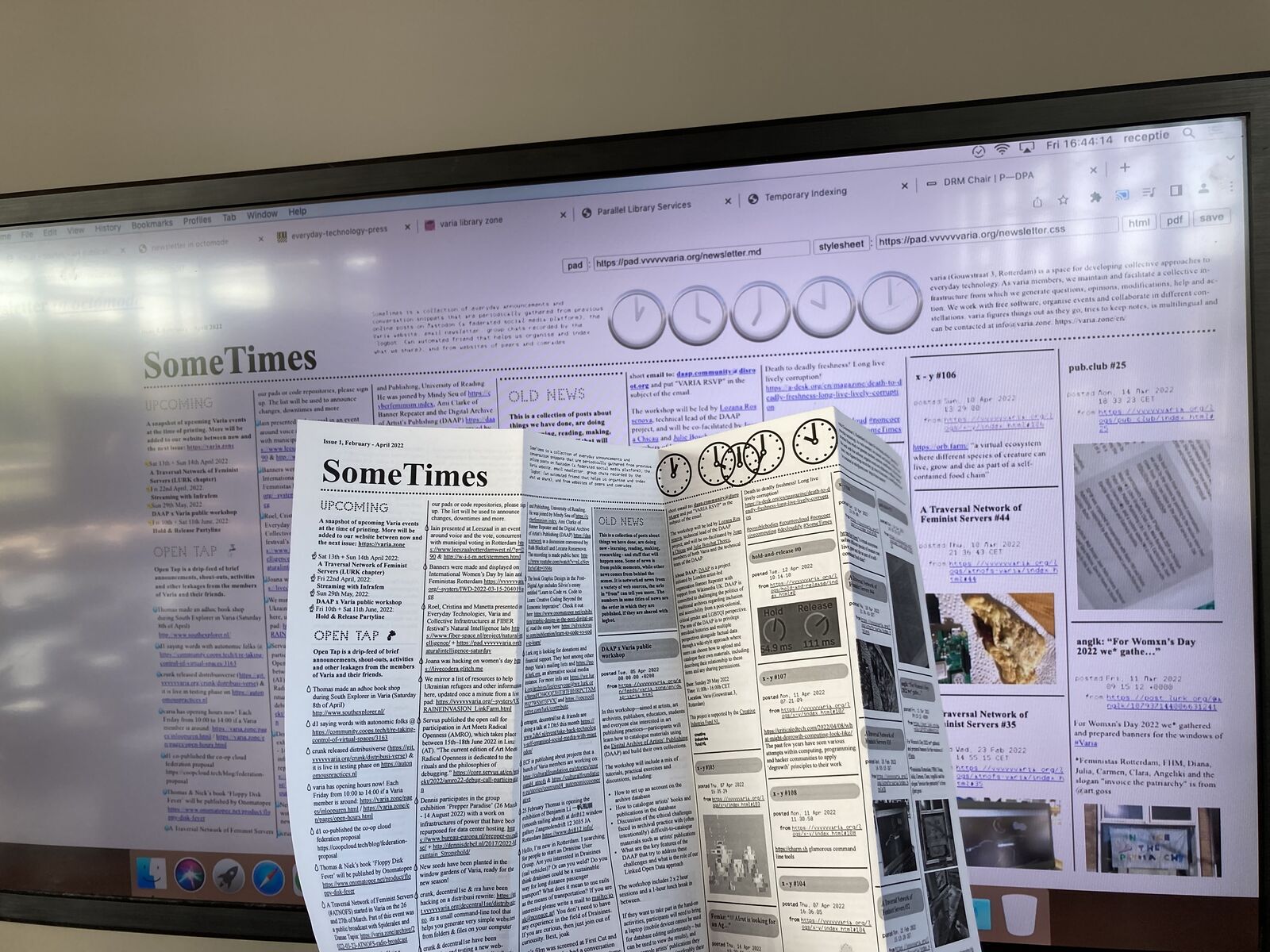
Varia members have a talk in Catching Up in the Archive
06-05-2022
Simon Browne, Silvio Lorosso and Danny Tirthdas van der Kleij
Danny Tirthdas: Hello, I’m Danny, I’m a Varia member, Varia is a collective space, so something in between a space and a collective. Focussing mostly on and around this umbrella term of everyday technology. So yeah we reflect upon technology in society, but also deal actively with technology, with a collection of different types of artists, graphic designers, writers. I think for us every day technology means that technology is sort of equal, on many levels. So we would see something very complex and technical like databases or websites or, instant messaging apps, as equals to things like a printer. A riso printer or, very mundane technologies, and these technologies can be discussed and examined. In many different ways. We’re also a collective in a sense that we have as much opinions as members, so what Varia is, is also always in motion. Never from here to here, its never the same. Not only in something like organisation, in 2017 we still had a board, in a serious way, and then we went from a board to some sort of core group. And now we don’t have that anymore at all, we’re a completely horizontal organisation. Every member is seen as an equal. That means, instead of having one treasurer, we have one finance group, that members go in an out of. So Varia members can see the entirety of the organisation. But also in terms of what Varia does. I think in the beginning, 2017/2018, we still had a lot of smaller events without planning. Just going by the ideas of the week, or ideas of the day also. Very influenced by the neighbourhood or artists in the neighbourhood that wanted to do something in our space to a more and more structured programme. I think now we are slowly transitioning from trying to think as public as possible to a bit more research. You can see it a bit in the website, I don’t how to scroll on a mac. Wow I have to scroll up to go down, oh okay. I once found out, so we now have ___ on the website, and then you can see a bit more towards the past. So a lot of smaller events, movie screenings, reading groups, things like book launches, or record launches from musicians, now we’re slowly going towards eh, yeah.
Jacquine van Elsberg: Can I ask how you can become a member?
DT: So, yes, this is a very good question. To become a member of Varia you pay a membership fee, but you have to dive into also a little bit of how decisions are being made. And that group dynamic for us is very important, so we are nineteen members. Quite a lot, but it’s in a way also for us as cultural practitioners a safe space. We work in a place that is very comforting to us. So its very difficult to say this person fits with us, in this entire group, perfectly. So we have this sort of system of this is not very important, if you want to spend some money from the Varia fund, you can just do it. If you want to hold an event as a Varia member you don’t need to ask us or other people. But something that includes all Varia members, It includes all members, affects all of them, so this has to go with full consensus. We have a monthly meeting, and once every 6 months we accept new members. And this has to go through full consensus before someone can become a member. And we’ve had quite a bit in the past that someone wanted to become member but this didn’t seem so logical. If it is you’re idea to work in our space, use our space, but not us as a collective, and not Varia as an entity that you want to push forward, then yeah, you’re welcome to work in our space you do not need to be a member for this. So we for example have cultural workers united, and Bond Precaire Woonvormen, precarious living situations, they use our space, but none of them are members, they just use the space as they want. So a Varia member is quite a particular thing. So we also have quite a bit of discussion on what this actually means, right now. We’re five years old and if we just open the doors to anyone becoming member we’re going to grow to 40 members, really quickly and I think that’s now for the dynamic now not so healthy. We even have a member stop now, so it’s a long process to become a member, but this is also really to safeguard our identity and way of working. I think, because I was there at the start, Varia isn’t only a space that deals with these sort of technological issues, from quite a bit of a feminist perspective, I would say personally, yeah but 19 members, but also a bit from an anti-capitalist perspective. You wouldn’t?
Simon Browne: No I’m joking! Im in shock!
DT: Really! I didn’t realise!
JvE: And is it also locally? Like members have to live in the neighbourhood?
DT: No, because we have a member in Sweden, we have a member in London, I don’t live in the neighbourhood even.
Silvio Lorosso: But some do
DT: Yeah some do, and I think it is, like we have a member in Sweden but he used to live in Rotterdam. But I think Varia also really started to have projects that aren’t super suited for funding application, or getting through for call for works like to be the best but something that is maybe a bit more unsure, that we also don’t know what the outcome will be, to facilitate a space for that. This idea of new members can also disrupt that, we’re quite protective of it I think. Should I talk about Collective Infrastructure?
SL: Yeah that would be a good idea I think.
DT: So we have something that we call Collective Infrastructure. Which I think can be divided sort of in to two things, so online hosting and offline hosting. Offline hosting or physical hosting is I think what we just discussed, like with other groups using our space. We have also other people using our space, we have quite a lot of printing facilities, riso, laserjet, plotters, also now hotglue binders for paperback books. Also surrounding institutes or people in the neighbourhood use these facilities. That’s also part of the physical hosting, we also now have these open hours, from 10:00 to 14:00 in that the space, so that’s physical hosting. And then we have hosting on our web based practices. This includes etherpad which is an online collective writertool which we use a lot but also other people that want to use a tool like that but don’t have the know-how to run a server, they can also use that. We have radio-streaming software, to re-stream other radio streams when this is necessary this is a similar idea we share with online resources. There’s a bit of an overlap between these two because we have a server that is physically in the space, meaning that if our power goes of the website also goes off. Plus all our tools and all our infrastructure. And then we cannot message each other anymore, when the server is off, so this is quite a radical step but so far it has worked out, I think in five years the server has been off maybe tops 10 times. So that is not that bad. This 100% online modern way of viewing that is also not something I can stand behind. So sometimes the website is off but we have everything under control in our space. So this is also, our online hosting is also in a way physical. Its in the space, it’s a machine, it’s there. Sometimes you have the computational power to do something, the machine is quite good but we have a Tele2 30,- euros a month internet subscription, we don’t have anything professional, so video screening from our space doesn’t work. But radio streams, downloading, chatting, these kinds of things do work.
Nell Donkers: Do you show video’s and what do you use then?
DT: We use, for our own communications, we have a video chat, we use Jitzi, but we just pirate somebody else’s server for that. Sometimes we use Greenhost but I don’t think we’ve ever emailed them to say we’re going to use your thing, but I don’t think we’ve actually thought of streaming video. Also a little bit because that is then in your mind, like, you can’t so you won’t. And then you don’t really think about it anymore, like you don’t have the capabilities to do it so. Ehm, we have some sort of friends collective called lurk.org (?), where some Varia members are also in that group and they would have the capabilities to do it, so that’s also a little bit closer to yourself. You know who they are, you know who’s running their server so then instead of going to like youtube or twitz.tv (?) you do something else locally run. But we’ve never done that.
SL: You can mention the___
DT: Is there a link here cause I don’t know…
SB: I think it’s just stream.varia.org.
SL: Yes because you know as Danny was saying this idea of limitations led to a form of tool making that fit those limitations. So for example, we did like some broadcasting events, and I call it narrow casting, because like, the limitations are very strong. There is only the audio, but, all that we are missing in terms of like the ornamental, the high broad-bend necessity of like a platform of Zoom or Jitzi even are like content balanced with a playful approach to the interface. We design very often like specific interfaces for each broadcasting events so you can join the broadcast and participate in the chat and we would like completely rearrange the interface of the bend. So that’s basically what we gain is that kind of freedom. So like, if you manage to go to the archive there are like some pictures there. Yeah there is no link…
DT: There’s no link at the end.
SL: So it would be by hand, maybe I can do it. Uh, do you want to go to the Octomod (?)
DT: Yeah we can talk a bit about that.
SB: Hi, I’m Simon, I am also a Varia member and I’ve got some of these here today. Which are made with these tools that one of the Varia members developed. So this is our first printed newsletter in English and sometimes in Dutch.
All: Af en toe.
SB: And the way this publication was made was together using this online collaborative writing tool. Which allows a lot of people to work together on the publication. But also we can take different streams, things that have already been posted, because all the member are already posting things , on the social media network ___, or on their websites and then we can take all of that and make the publication in a timely way. You don’t require one person to decide on all the content. But yeah, the tool itself looks something like this, which maybe is not so impressive, this is the text editor, but you can also change the style of it, to make the book like a thing. And you can also preview the pdf, eventually. Yeah, so this is the very first edition of this that we are working on. We’re also starting to use this as a tool in many ways, for zine’s, very quick publications. Especially one’s where you can have like 10 people working on one document and you just can make it fast. So yeah, sometimes, yeah I’m also starting to make a publication for ___ that we’re starting to post together in our private chats. Ehm, and I guess this also connects to publications that Varia is producing, there is also Everyday Technology Press, you want to talk about that?
DT: Maybe you can show like one of those research labs or?
SB: So yeah, all of these are hyperlinks so, that is where the content comes from. We’re using like a chat to post things and then in the chat you can ask a bot to take an image or text or URL and then archive it. In an html page. So all of this is here including all these images, and when we’re making this publication sometimes anything that is added by this bot goes into the publication, of course this is a stage rather at the end where we have to think about considerations the prints that aren’t so apparent when we’re thinking about a webpage like for example where does text flow, how does it flow to the next point, how does it know where it ends. An html page doesn’t really have this notion of like limits, but yeah, this is one of the logs that makes up this publication.
ND: And, really practical question, is it then time-saving?
SB: Sorry?
ND: Time-saving! To do it like this?
SB: There’s 2 reasons why we’re using this. It’s very horizontal, in that nobody has to take the power of being ‘the editor’, the ‘copywriter’, we just do it simultaneously. So we decide to work on it for a few hours together, we just share those roles. But also because then we don’t need to make it in this very linear way. We have all the content decided first and then we make the design. So it kind of happens in tandem, yeah it is time saving but also it’s a nice way to work because we don’t have this strict division of labour. Anybody can participate, even if you don’t know how to write you can also learn through the process. By seeing other people doing it. And there is this division instead of with more traditional publishing houses. And its also useful because of what is called Single-Use Publishing, so you start with something in plain text, then you can publish it in different formats it can go into pdf into webpage and to many different places, so you can also use the content for many different purposes.
SL: In a way you can say, like the single-use publishing was a bit like the dream of small publishing houses because I, it would save time, you do it once. But the beauty of this, in my opinion, its like multiple source publishing into one, there are like different flows of discussion that go automatically in a publication, so its like that dream reversed. So its like, speculatively reversed. So you have this things that contains it all.
SB: Also this is maybe suitable to Varia because, we don’t have a style guide, we don’t have a logo, we don’t have like a visual graphic identity. And you might see like in this publication like we’ve got these clocks at the top, and this is because this was exported by a member that uses Linnox (?) whereas this is Apple and you have like other, yeah it depends on like who is doing the final export as well. But they’ll be constantly changes in this identity, and its very common or typical to Varia to have these changes. To have like this non-consistency, or inconsistency, maybe. But its quite nice also to see, cause you can see like that was made by an apple computer or that by a linux computer. Yeah so ___ you want to talk about ___?
SL: Yeah, sure. I can stay here, maybe.
SB: Do you want to take the chair?
SL: Yeah okay I’ll take the speaking chair. Okay, now I’m allowed to speak on the speaking chair. No yeah, basically, recently we published a publication, actual publication in the sense that ISBN with Varia. We built like our own imprint, let’s say. Which is called unsurprisingly Everyday Technology Class. And this publication is called vernaculars come to matter, (?), edited by ___, and it came from, like the inspiration was this toolkit called the natural language toolkit, right? NLTK is the acronym, and its basically a programming library that you use when you have to do more or less complex programming. For example when you have like a bunch of text and you want to highlight the ___ like the verbs, the adjectives, the etc, and you know there was like something fascinating about this notion of natural language. As like opposed to non-natural languages. Like programming languages. And Christina, Julie and Amaretta (?) were like fascinated by the idea of looking like how to understand this natural languages and how it is constructed within this library. So we tweaked a bit the notion, and thought how can we incorporate more vernacular sorts of language in these tools. And then they opened up, like the discussion. So inside you find like contributions of for example the graphic design language of well mostly Turkish based neighbourhoods in Rotterdam, so its like this nice exploration of them in Rotterdam. It’s in the whole Netherlands. So also like, the ingenuity in which like advertisement is presented, so this is like, sorry I have to read it. This is by ___ who is a Dutch/Turkish designer, so it’s like doing this kind of archival work, somehow. On a continuative basis. Then you have like a contribution on like the politics of that naming (?), so how do you manage the issue of using the name of like a transgender person who doesn’t want to be reminded of that name in situations like quotations and archival spaces. So like, how do you deal with that. And there is an interview with Rosemary Grannen (?) from __ archives which is a beautiful, fantastic archive of activist material in the UK. And finally there is a contribution of Michael Muorto (?) which has to do with somehow understanding the kind of tools that we use for image processing. It’s a sort of critique of this kind of programming language called Processing which is very much used with coding which has a very sort, according to the author, modernist approach to image making somehow. If you look at the example of conteptual art of the 60’s and 70’s in a white cube and eh, clean and sleek design so. The tool which is also used to make this book is called Image Magic, which is more rough. And the example to make combination with images are already way more rough somehow. We’ll see them here. So of course this is for de Appel, for the archive. So an unofficial donation. Basically this was also an opportunity to enter, again like with this notion of everyday technology we also mean technologies of distribution. For you like matter of fact things, but for us, to learn how to actually obtain an ISBN how to deal with the depot, like they ask you for some copy, so I find that very useful and fascinating. Not to get the book out but also engaging with, actually shipping them, developing an understanding of the cost, the very system of the books. So for example the bookshop was like designed by a member of Varia, and you cant see much here but there was a lot of work to understand the pay system, because we went from scratch, seeing like how to combine PayPal, Ideal, maybe a problem that we have that kind of work, that kind of backhand work is very hard somehow to communicate that, and we are working on that. So this is also a lobby opportunity to speak about.
ND: So is this open source to use?
SL: I mean, yeah, the code is all available. Of course the pay system, our interface, of course are not open at all. So if you have to use PayPal you just interface with them, you don’t want to have to much margin. Because that’s what people use, so. We are of course fond of free-software. We always interface with non-open, commercial, exploitative services to, but we try to do our best to develop a degree of autonomy, let’s say in this technological system, let’s say.
ND: I’d like to know more about this!
SL: Yes, please please!
ND: Like with The Remote Archivist, I am wondering, how do you deal with the addresses? Is it only in your database?
SL: That’s a very good question, in the sense that someone pays something. There are like 2 options at the moment, I mean, if people go through PayPal but there is like another option for example if people don’t have a bank account, or they don’t use it then we have like a simple form that is like an e-mail. So it’s like as if they are like sending us an email individually. So we don’t keep, at least not consciously, a database. Also because we are small. It’s just the beginning.
SB: Yeah, I just want to add something on the open source thing. It’s for a lot of people also like being something to build. It’s like you can build it on top of tools. There a lot of reasons why people prefer this use, the large part is that we can then extent, when we communicate with each we use ___ we can also build on top of that, but if we’re using let’s say WhatsApp we can build it on top of WhatsApp. And it’s also so you can make particular things. Like, with very particular needs. So it's not something that would work for everybody but say a very particular need comes up in Varia then often it is okay that you’d want to use open source tools. To address that.
SL: Yeah, that one, the newsletter, wouldn’t have existed in that form and shape in that system. If we’re using another tool for chatting among us. So there is a sort of encouragement to play with these things. Which is good, like our app, which is also what the tools call for, is very easy to make, like an open box that collects these materials when we chop, it’s frustrating at times. But then we have like other forms of gratification let’s say.
SB: Yeah, I can talk about this but maybe you want to talk about the Varia library.
DT: Yeah, speaking of libraries. This is really, like meant for one specific reason in this way. And also, open source, because this entire system was made by me. And it’s open source also. We had, in the beginning of Varia, and we still do we have this notion of workgroups. So we had the Riso Work group to fix the Riso, we had the infrastructure work group for maintaining the server. And quite quickly we had a library work group. But not a library system, that was not, it was just a pile of books. So we tried first already existing systems. But we got really stuck with the idea of something digital, so, are you going to upload the entire collection of 10.000 pdf’s, are you going to do that? Or you just won’t because you already have them. How do we share actually these books between us? Who do you compete with, like Monoskop.org? These huge digital libraries? So we went through a few of these ideas, of using existing systems, that we're open source, and then maybe to adjust them but in the end we didn’t do that. So we just started to label everything we have, in a CSV-file. So no actual database, this is just a text file. That everybody can see, everybody can edit it also, everyone can edit mistakes, if there is any. And then this page is A. a tool to just see what’s in our library and B. to upload new books, edit them, and to borrow. So we have these 2 things that you maybe not always see in library systems, a custodian, because sometimes you put our important books in our library for other Varia members, but you don’t give them to Varia, they’re still yours. And then if all of a sudden your expensive, one of a kind out of print, book is missing in this system you can see who borrowed it. Most of the time the custodian is Varia itself, and if you go back and then you go up, there is a little bit of a filtering system that is adaptive to what is in the library. So if something from a year that is of a year that we don’t have anything of it will just automatically adjust itself. The funniest one I think is your box of cards, under type underneath there is a box of cards, and there’s only one box of cards in our library and that is your box of cards.
SB: Yeah cause I created that type. You can’t choose which one
DT: No there is nothing to choose you just fill in whatever you want. There was a bit of a reading and repairing sessions event that were tied into this, and I think it didn’t always work all too well, but it analyses the text and the reading materials from these events, to automatically recommend more books that are in our library, I think if you go to my event that there…
ND: On what criteria then?
DT: There’s just fields, highlights and comments. And if those match it will see this and this book is similar and so if there is an event on the radio it will recommend other radio.
Remco van Bladel: So it’s just the concept of ___ pile__?
DT: Yeah, and then if there is an image with the same idea as the book it will show another one. Yeah it’s really reducing all the ideas of archiving. Holding a library as something as simple as possible. Just to get us started to think about what we have without having to confront a system first.
SB: Yeah I can talk a bit about this now, maybe also connected to the cards in a way. And I think there’s a set of cards floating around somewhere. ___which was published by de Appel a few years ago yeah it was like a work that I did, connecting libraries and, yeah you can pass it around, so this is something I did before I became a Varia member, but at the time I was also part of the library workgroup. Which is a bit weird maybe. But yeah around that time I was also thinking like a lot about distributing things, mostly pirated text. And the problem you go into very quickly is that you become a service provider. So if you’re pirating things then all of the heat is on you. Plus also I felt that there were a lot of people that had knowledge that was quite useful. Which could create more of a collegiate atmosphere of sharing this knowledge. In particular documentation, so through Varia we started these series in September 2021 and finished in March this year. It was quite long. We’ve made maybe once or twice a month from like 10 different participants all over the world. We gathered all this documentation here but it was mostly from different workshops we did where we were experimenting with different I guess practices of amateur librarianship. This would involve things like scanning, editing, indexing. And also kind of like making up all these tasks. this is kind of related to these cards here, trying to define them and trying to look at them as a bunch of practices. Because when there is no archivist, no professional archivist, or no embedded librarian then everybody performs this role. So it’s this sort of thinking about it as one person’s job and how can we deconstruct that to different practices. So this is one thing I did as part of that. And then after ___I created this web-app called Pre-Indexing. A lot of people where using the software called Caliber which is, it’s open source. You can use it to manage a collection of e-books. If you have a private collection you can share that using the software, but yeah what I found was a bit of a problem was that people would keep a log in it. You keep a lot of PDFs in your computer that you don't ever read or even look at and then also we label them in quite different ways and I was quite interested in seeing how people might have different ideas about a text that they have and how they might record that metadata. So this tool is activated in what you’d call a print party where people gather together and you can upload metadata file into this ___ file box here then you can choose which side of a printed card you want information like the title of the author, comments or the timestamp or tags either side angle side be and click generate that it will produce a PDF that's imposed, is A4 but made up of A6 size cards so you can have them on the correct side you can count them and then you can share them so the tool is part of it but really big part of it is actually the social conventional decision to meet together and share these cards. yeah it's quite a weird intimate experience going through someone's digital library with analog paper cards also bit nerve racking if we do it cause then you realize that you’re private inability to record things or maybe how anal you are about recording things would be exposed to other people but also an interesting way to say how we might think about ontologies in different ways for some people is completely unnecessary to record the subject cause I know the subject, for some people that do it very meticulously. I remember Sylvia, you gave me your metadata file that was very meticulous actually. I'd also like seeing the library and physically in printed for them you know like you may have 1000 pdf’s on your computer and you don’t have any sense of what that is but they would print out the cards and they're like, I don’t know a 1000 cards. Becomes quite different. But this is something that I'm still kind of working on quite a bit and I guess like also this relates to what I'm doing with sometimes with printed publications and maybe thinking about like this connection between a digital or an analogue interface from library or collection.
Mariana Lanari: Yeah it’s really nice also how it can work together also. But actually you upload it through caliber?
SB: No, you just upload it onto the website.
ML: I just think it’s a nice getting together with both libraries.
SB: Yeah we talked a bit about like housing things and how the Varia collection and it could be a nice way to sort of reindex.
SL: Curiosity, does anyone here use calliber or callibra?
ML: I use it.
SL: I'm always wondering like how common it is as a tool.
ML: I use it but I kind of made a mess of my Calliber because I upload metadata and then I changed my my mind so it's not something that I have the time, you really have to care for it little by little.
SB: I’ve also run libraries using calliber web which is I guess it development on the original project of caliber. And caliber is, you can use it on your computer as a desktop app. And Caliber web is made for in the browser for the web but here with caliber web you have a slightly different interface and it’s a bit more about I guess sharing or distributing within the possibility to share books with each other.
ML: Yeah it is like sort of a server, I tried but didn’t succeed.
SL: Maybe this is good, it is a terrible interface it’s very cheesy. It was like this big heard and was basically a tool to manage your your book library. The advantages is that a lot of the metadata can be downloaded automatically covered and stuff so it is really tidy and is good also for exporting bookstore, to convert. So a lot of people use it just for that and then the collection thing is secondary or like even.
SB: Can we show caliber web? So this is the dark mode interface and so essentially it’s the same software but with a different interface. It’s a little bit like Spotify or Netflix. This all you can eat endless scrolling, collection of things, and that really changes things quite a lot I think but calliber web has this other feature where they could shelves and you can create it's not really a shelf is just like a grouping of things they can have public shelves and private shelves. So say you want to make a private shelf the only you can see the books that are or if you want to make it make it public then you can edit that with other people so different bit of a different way to classify. It's not using tags or categories in a bit more horizontal. But yeah this software often you'll find that people who use it because they want to read their E books on their iPad in their living room you know that's mostly like single user kind of thing. There is a possibility for it to be used socially which I find really exciting. But yeah if you want to extend it then it's open source but you need to contribute. it's not just not just picking the fruit you also need to water roots.
DT: Yeah but caliber web is quite large for the Varia website I considered it but it took me hours to rewrite the things that I wanted. Therefore we started from scratch, much more simple, which is really also about our physical library. So there was no dual PDF’s.
ML: I thought it would be nice to use your library to print those cards, to recreate the library cards of what is in the library.
SB: Even in libraries where they have digital systems, they still write out a coal number on a piece of paper.
ML: I had this problem with libraries, that when you see the library through the library system you never know what is the scope of the library. I want to see like what is in this collection. As well as perhaps, for me a library is not a place where you search for a book but more to discover books that are there. I was very interested in that location, those people.
SB: The catalogue card is quite a fascinating interface too, like an analogue interface cause it has two sides that exclude each other. You kind of see both sides at the same time so then you can use those two sides like the tool that I made the web app being able to print like say some details on one side but not the other gives you also a different view of the library depending on how you are flipping through the cards right.
ML: I’m really interested actually in trying that out. You create also a box that is the library, right.
SB: The set of index cards becomes a library, but also becomes a book.
ML: The book at the end of the day is really interesting technology to put the library in. To hold the library, somehow.
SB: You should come to Varia I still have a lot of paper left over. You’re welcome to use it.
NL: I still have the cards in de Appel Archive.
SB: Yeah, oh nice! And Mariana was saying that you use them sometimes. I was happy to hear that.
ML: Often times when I do visitations I use this box actually that I distribute. We also add to it.
SB: That’s the problem with it really.
ML: If it was bigger, that would really naturally happen because I also use the same size pages.
SL: Okay, last project related to all these obsessions and interests is a project as a by-product of my PhD research and it’s an archive even though the word is imprecise but let’s say it is a collection of structuring of a lot of projects that somehow comment on the status of publishing when somehow informed by digital technology. And of course similar problems, similar questions that I went to, I want to show you an image in particular. You have this problem when you want to develop an ontology at a certain point you have to stop now you have to say OK I cannot categorise everything. You enter this vertigo with what you want to categorize. What is important, what is not important. And then everything starts to seem very important. No I just find the number of pages the price, the materials etcetera, so I enter in this vertigo of categorization and since I wanted to comment specifically on one aspect of interactions between artists and publishing. I went for of course there is a on the backside a complex categorization of number of pages, price, where you can buy it etcetera. But one category that I think is specific to this archive is like, is in particular to this past year. So the technologies involved in the project because a lot of the project I was discussing in the thesis are projects that cannot exist without certain platform because they both use them and comment on them. I'm going to show you just one project to give you an idea and I think the platform in this case I don't know if I put it here let's go through medium again like we have this issue of strange mediums like a mug or the one I’m searching is chair. Is it here? Yes this chair, I don’t know why it’s not in chair as a medium. Like, a lot of projects I was discussing were like this, they weren’t publications. In any possible way unless you start saying everything is a publication. But this speaks a lot about publishing because this is basically a chair that annulate’s like the digital rights management that adobe incorporated. So the system works like this. You borrow a book, from a digital library and to make sure that the book is not spread to many times after like 12 readings it sort of self destroys. So basically to show the absurdity of this kind of digital scarcity they say OK let's do it but let’s apply it to a chair. So you would sit 12 times on this chair of something like that and then the chair will collapse. So you can see it in the video, so, basically during this project was that in order to speak about publishing and digital publishing you have to look at things that are really not books. Not even close to enter like a bookshop or like a bookshelf or like a library. Maybe I put the video course I guess you are curious. Yeah this is up there a couple of pieces of a group from Switzerland and its basically the result of a workshop. And another thing is that a lot of very smart and ingenious projects weren’t somehow the project celebrated in museums are not collected they’re like results of like two day workshops and they then they disappeared so I felt the urgency also to give some space to this student project which are very often very on point. Now very attentive to what's happening in terms of legal framework, system, so a lot of people involved.
ND: Smart
SL: Okay I guess we don't have anymore links. Thanks so much for the attention!
SB: How do you decide it should media chair? Media is such a difficult category I thought.
SL: Yeah let me check how I categorise it. Furniture, Ikea. Medium installation. I went general. Like I put mug, like there are a lot of people that do stuff with print on objects like mugs.
SB: Yeah its difficult like when medium and format, because you can say medium installation format chair.
SL: And here I didn't put the platform because it's actually this system is not specific to Adobe but is mostly Adobe they use. so that's why is missing.
ND: Keywords is also really problematic.
SL: Yeah, I use my set. Not to many. I think the best thing with keywords is to decide to say okay Max 5. I don't know I mean it really depends this is also curated by 1 person so not a big deal to be disciplined that rigorous. But I mean not when you have this scale of archival.
ND: The keywords in de Appel archive are now underwater indicators. We cannot show the keywords anymore as keywords because they are politically wrong. Like ‘decolonisation’, ‘queer’, ‘identity’. Those things are all ‘ingehaald door de tijd’ (ENG: Overtaken by the passing of time).
Mohamad Dib: Like in the 80’s key terms were like bisexual performance and now these categories are obsolete. You either update them or keep the old ones.
SL: Yeah it’s a bit like similar problematics that like is like one of the contributions of the book. How to deal with the past, basically.
DT: Actually there was someone who critiqued the use of the word vernacular in the word Vernacular Design. Like two weeks after that book was launched.
SL: But referring to the book, or in general? Yeah again like, vernacular is a problematic term.
JvE: In Dutch it’s ‘Volkstong’. Its like a little bit denigrerend, hoe zeg je dat, like average people
SL: But vernacular comes from slaves. The word. Roman slaves. That’s like the language of the slaves.
JvE: it’s like gepeupel.
MD: But its commonly used in English we say like vernacular architecture.
SB: Its more towards like being like slang. Vernacular like slang.
JvE: No its not slang, slang is like a way of speaking in a certain neighborhood. Volkstong is really average.
ND: Is it not dialect though?
JvE: No, no, I even was searching for the word now that we’re talking. I was searching for the word itself.
DT: Yeah in terms of keywords and indeed archives this can indeed change. Become problematic or not.
ML: In the case of the system we are using is totally the opposite like anything can just be a keyword. Because we don’t group. And the ontology is actually the minimum definition possible. Of course it can complicate but let’s say we separate medium from content so, a book is an object, a magazine is an object. So we archive from the perspective that it takes space an object. And the content is completely separated from finding this actually as an object. So let’s say the page is also an object. A file is also an object. So you kind of likewise types in the most abstract way possible. Like the least amount of defining. So like more sort of upper-level mid-level, and the objects speak for themselves. But of course it’s because of the kind of database that we’re using allows for this. So like we just use the type of objects that are present in the database here. Then on top of this there is text. So the content and the text gets accesses through annotation of this title and object and it needs to have an object.

